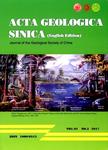Thrust Propagation in the Aqqikkol Lake Area, the East Kunlun Mountains, Northwestern China
Thrust Propagation in the Aqqikkol Lake Area, the East Kunlun Mountains, Northwestern China作者机构:Chinese Acad Geol Sci Inst Geol Beijing 100037 Peoples R China
出 版 物:《Acta Geologica Sinica(English Edition)》 (地质学报(英文版))
年 卷 期:2003年第77卷第4期
页 面:468-478页
核心收录:
学科分类:070904[理学-构造地质学] 0709[理学-地质学] 07[理学]
主 题:western segment of the East Kunlun Mountains thrust propagation normal slip plate collision dynamic model
摘 要:The western segment of the East Kunlun Mountains is one of the poorly studied regions in northwestern China. Through a structural analysis of the typical sections, we have the following views: (1) There is a very well developed fault system in the western segment of the East Kunlun Mountains and thrust propagation, normal slip and decoupling are the chief deformation events in this area. (2) Although the thrusting started in the Late Carboniferous and Late Triassic-Early Jurassic, strong activity took place in the Miocene-Quaternary when the Kumkol basin was strongly downwarped. (3) The tectonic pattern of coexistence of N-directed thrust propagation and S-directed normal slip in this area is consistent with the general tectonic pattern of the northern Qinghai-Tibet plateau and also very similar to that of the Himalayan region on the southern margin of the Qinghai-Tibet plateau, but their directions between the thrust propagation are opposite and all the strong thrust propagations occurred from the Miocene-Pliocene to Quaternary, a period featuring strong collision between the Indian plate and the Eurasian plate and abrupt uplift of the Qinghai-Tibet plateau. This oppositely directed thrust propagation and normal slip reveal such kinematic characteristics as symmetric propagations of deep-seated materials towards the north and south beneath the Qinghai-Tibet plateau and gravitational sliding of superficial materials towards the interior of the plateau. Therefore, the establishment of the fault system in the study area may provide an approach to the study of deep processes of the northern Qinghai-Tibet plateau and the construction of a unified geodynamic model for the uplift of the Qinghai-Tibet plateau.



